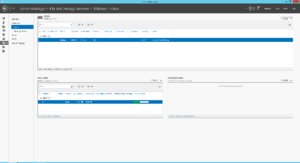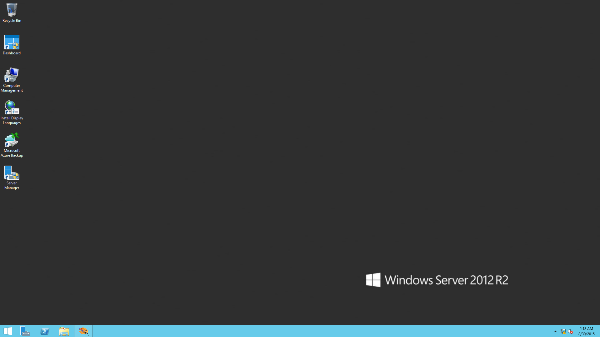Thecus W5000 WSS NAS Review
Low-cost Windows Storage Servers (WSS) give small businesses access to enterprise-class features at a desktop price.
Why you can trust Tom's Hardware
Software Interface
On the surface, Windows Server 2012 R2 and its derivatives look similar to Windows 8. The Start menu is missing, but you still have desktop icons and a Recycle Bin. Moreover, this operating system can run all of your Windows applications.
The system has a Dashboard feature that guides users through configuration, settings, most used options, users and user groups.




You also get access to Microsoft's Pinpoint marketplace. Think of this as the Microsoft Store for Windows Server 2012 R2 Essentials. You can navigate to Pinpoint through this link. A few applications are found here, and you can rate and review the software. It's a nice start, but the selection is limited compared to the number of add-ons Thcus makes available for its Thecus OS, based on Linux.
Windows Server offers an easy backup feature that works seamlessly with other Windows-based PCs on your network.




Server 2012 R2 gives you access to the NAS from remote locations and uses DLNA to share media. BranchCache is a nice feature that syncs files and folders from the NAS to other systems.
Moving away from Dashboard, the Server Manager lets you adjust other settings. This is also where you dive into Storage Spaces.


Windows has built-in roles and features as well. Some are easy to set up and others are more complicated. If you've never built an Active Directory before, then you'll probably want to read up on it first. Other options, like configuring the system to act as a DHCP server, are much easier. Fortunately, Microsoft offers a number of extensive walk-through articles to get you started. And if you don't want to mess with tracking down an official how-to, there is always a video on YouTube showing the easiest way to perform an action.
Get Tom's Hardware's best news and in-depth reviews, straight to your inbox.
Storage Spaces let you build pools of storage, arrays and even SSD cache accelerators. RAID 0, 5, 6, 10 and JBOD are all options, though given the number of drive bays on the W5000, we recommend RAID 5 as a single volume.


iSCSI works flawlessly as both a target and an initiator. You can share storage with other PCs or even import additional space from other servers.
As your WSS knowledge advances, you'll be able to make configuration changes using PowerShell, the modern equivalent of a command-line interface.


For the rest of us, there are always apps, scripts and add-ons that resolve Windows' shortcomings. Sadly, we haven't found an application that fixes the low write speeds you are about to read about, though.

Chris Ramseyer was a senior contributing editor for Tom's Hardware. He tested and reviewed consumer storage.
-
Deuce65 "Low-cost Windows Storage Servers (WSS) give small businesses access to enterprise-class features at a desktop price."Reply
Um, is this a hardware review or a press release? -
Travis Hershberger While many people may actually use RAID 5 with this device, this is what we call professional malpractice among IT pros.Reply
Ref: http://www.smbitjournal.com/2012/11/one-big-raid-10-a-new-standard-in-server-storage
http://www.smbitjournal.com/2012/11/choosing-raid-for-hard-drives-in-2013
http://www.smbitjournal.com/2012/11/choosing-a-raid-level-by-drive-count
http://www.smbitjournal.com/2013/06/dreaded-array-confusion
http://www.zdnet.com/blog/storage/why-raid-6-stops-working-in-2019/805
http://www.zdnet.com/blog/storage/why-raid-5-stops-working-in-2009/162 -
CRamseyer You need to understand a couple of things about all of those articles. The articles are not talking about your home or small business NAS with four or five drives to start with. The ZDNET author has a history of writing articles and article titles to bring people in. Many disagree with Robin's findings. I wouldn't say that is the case with the only article that relates to this review though, Why RAID 5 Stops Working in 2009. In that article he references a 7-drive RAID 5 array. With 6 or more drives we use RAID 6 (RAID 10 in some cases) for the very reason he cites. With five drives and in a home or small business environment RAID 5 is sufficient as long as you are proactive. Keep the system on a battery backup, keep air vents fee of dust and if a drive fails replace it right away.Reply
Some users may want to take redundancy to the next level and run RAID 6 on a 5 drive array. That is fine and I know people that do. I don't recommend it on a sub-1000 Dollar system that already has performance issues with RAID 5 though. -
Marco Ullasci "We rarely hear of failures in the field"Reply
Here I am.
"In our own experience, NAS failures come from easy-to-replace fans and power supplies, rather than the main components that make up the heart of the system."
Changed power supply and changed fan but still no fun.
I had to dump my DS411Slim after putting some € on it in an attempt to fix.
The brown thing happens.






